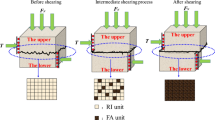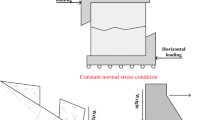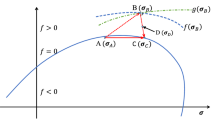Abstract
In view of the deviation of the fitting results of the classical exponential model and the hyperbolic model (the BB model) from several experiment data during intermediate stress period, a new constitutive model for the nonlinear normal deformation of rock joints under normal monotonous load is established with flexibility-deformation method. First of all, basic laws of the deformation of joints under normal monotonous load are discussed, based on which three basic conditions which the complete constitutive equation for rock joints under normal load should meet are put forward. The analysis of the modified normal constitutive model on stress-deformation curve shows that the general exponential model and the improved hyperbolic model are not complete in math theory. Flexibility-deformation monotone decreasing curve lying between flexibility-deformation curve of the classical exponential model and the BB model is chosen, which meets basic conditions of normal deformation mentioned before, then a new normal deformation constitutive model of rock joints containing three parameters is established. Two main forms of flexibility-deformation curve are analyzed and specific math formulas of the two forms are deduced. Then the range of the parameters in the g-δ model and the g-λ model and the correlative influence factor in geology are preliminarily discussed. Referring to different experiment data, the validating analysis of the g-δ model and the g-λ model shows that the g-λ model can be applied to both the mated joints and unmated joints. Besides, experiment data can be better fit with the g-λ model with respect to the BB model, the classical exponential model and the logarithm model.
Similar content being viewed by others
References
Shehata W M. In fundamental considerations on the hydraulic characteristics of joints in rock. In: Proceedings of the Symposium on Percolation Through Fissured Rock, paper no. T1-F, Stuttgart, 1972
Goodman R E. The mechanical properties of joints. In: Proceedings of the Third Congress on ISRM, Denver, vol. 1A, Washington, DC: National Academy of Sciences, 1974. 127–140
Goodman R E. Methods of Geological Engineering in Discontinuous rock. New York: West Publishing Co, 1976
Bandis S C, Lumsden A C, Barton N R. Fundamentals of rock fracture deformation. Int J Rock Mech Min Sci Geomech Abs, 1983, 20(6): 249–268
Barton N R, Bandis S C, Bakhtar K. Strength, deformation and conductivity coupling of rock joints. Int J Rock Mech Min Sci Geomech Abs, 1985, 22(3): 121–140
Saeb S, Amadei B. Modelling rock joints under shear and normal loading. Int J Rock Mech Min Sci Geomech Abs, 1992, 29(3): 267–278
Malama B, Kulatilake P H S W. Models for normal fracture deformation under compressive loading. Int J Rock Mech Min Sci, 2003, 40(6): 893–901
Zhou J M, Xu H F. Power function model of normal deformation for rock joints (in Chinese). J Rock Mech Eng, 2000, 19(supp): 853–855
Yu J, Zhao X B, Zhao W B, et al. Improved nonlinear elastic constitutive model for normal deformation of rock fractures (in Chinese). J Geotech Eng, 2008, 30(9): 1316–1321
Yin X J, Wang G L, Zhang C H. Study of constitutive model for rock interfaces and joints under cyclic shear loading (in Chinese). Eng Mech, 2005, 24(7): 1158–1163
Plesha M E. Constitutive models for rock discontinuities with dilantancy and surface degradation. Int J Num Anal Meth Geomech, 1987, (11): 345–362
Jing L, Stephansson O, Nordlund E. Study of rock joints under cyclic loading conditions. Rock Mech Rock Eng, 1993, 26(3): 215–232
Swan G. Determination of stiffness and other joint properties from roughness measurements. Rock Mech Rock Eng, 1983, (16): 19–38
Sun Z, Gerrard C, Stephansson O. Rock joint compliance tests for compression and shear loads. Int J Rock Mech Min Sci Geomech Abs, 1985, 22(4): 197–213
Matsuki K, Wang E Q, Sakaguchi K, et al. Time dependent closure of a fracture with rough surfaces under constant normal stress. Int J Rock Mech Min Sci, 2001, 38(5): 607–619
Xia C C, Yue Z Q, Tham L G, et al. Quantifying topography and closure deformation of rock joints. Int J Rock Mech Min Sci, 2003, 40(2): 197–220
Desai C S, Ma Y. Modeling of joints and interfaces using the disturbed-state concept. Int J Num Anal Meth Geomech, 1992, (16): 623–653
Itasca Consulting Group Inc. Universal Distinct Element Code User’s Guide. Minneapolis, USA: Itasca Consulting Group Inc., 2006
Jacobsson L. Forsmark Site Investigation-KFM01A-The normal stress and shear tests on joints. Svensk Kärnbränslehantering AB (SKB), 2004
Matsuki K, Wang E Q, Giwelli A A, et al. Estimation of closure of a fracture under normal stress based on aperture data. Int J Rock Mech Min Sci, 2008, 45(2): 194–209
Author information
Authors and Affiliations
Corresponding author
Rights and permissions
About this article
Cite this article
Rong, G., Huang, K., Zhou, C. et al. A new constitutive law for the nonlinear normal deformation of rock joints under normal load. Sci. China Technol. Sci. 55, 555–567 (2012). https://doi.org/10.1007/s11431-011-4654-z
Received:
Accepted:
Published:
Issue Date:
DOI: https://doi.org/10.1007/s11431-011-4654-z




